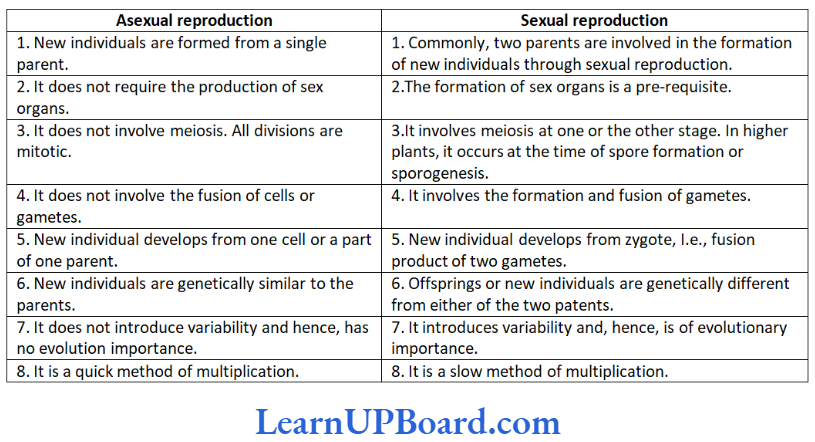NEET Biology Notes For Reproduction In Organisms Introduction
Every organism can live only for a certain period of time. The period from the birth to the natural death represents its life span.
Life spans of organisms are not necessarily correlated with their sizes. The sizes of crows and parrots are not very different, yet their life spans show a wide difference. Similarly, a mango tree has a much shorter life span as compared to a peepal tree. Whatever be the life span, the death of every individual organ- ism is certain, i.e., no individual is immortal, except single- celled organisms.
Reproduction is defined as a biological process in which an organism gives rise to young ones (offsprings) similar to itself. The offspring grows, matures, and, in turn, produces new off- spring. Reproduction enables the continuity of the species, generation after generation.
Based upon whether there is participation of one organism or two, reproduction is of two types: asexual and sexual. When an offspring is produced by a single parent without the involvement of gametes, the reproduction is called asexual reproduction. When two parents (opposite sex) participate in the reproductive process and also involve the fusion of male and female gametes, it is called sexual reproduction.
NEET Biology Notes For Reproduction In Organisms Vegetative Reproduction
In vegetative reproduction, new plants or individuals are produced from the vegetative parts of plants. Newly formed in- dividuals are genetically identical to the parent plant. It is common in flowering plants.
Vegetative reproduction is of two types: natural vegetative reproduction and artificial vegetative reproduction.
Natural Vegetative Reproduction
12th class biology notes
Natural vegetative reproduction takes place by the following means:
- By roots: A portion of root breaks and gives rise to new plant as seen in Dalbergia sissoo, Populus, Psidium, Murraya, Albizia, sweet potato, tapioca, yam, Dahlia, and Asparagus.
- By underground stem: A portion of underground stem bearing bud forms a new plant as seen in rhizome (e.g., banana, turmeric, ginger, Aspidium, and Adian- tum), corm (e.g., Gladiolus, Colocasia, Freesia, and Crocus), bulb (e.g., garlic, Narcissus, and onion), and tuber (e.g., potato and artichoke).
Read and Learn More NEET Biology Notes
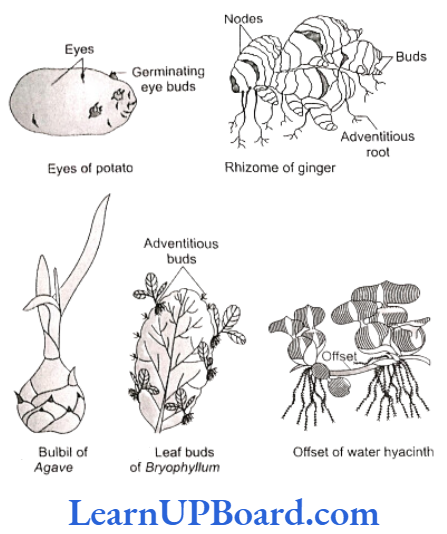
- By creeping stem: Examples are runners (e.g., grass), stolons (e.g., strawberry, Vallisneria), and offset (e.g., Eichhornia).
- By aerial shoots: Examples are Opuntia and sugarcane.
- By leaves: Examples are walking fern (Adiantum), Bryophyllum, Begonia, Streptocarpus, and Saint- paulia.
- By bulbils: These are fleshy buds which produce new plants. Examples are Agave, Oxalis, Ananas, Di- oscorea, lily, and Chlorophytum.
- By turions: These are fleshy buds in aquatic plants. Examples are Potamogeton and Utricularia.
Artificial Vegetative Reproduction
Artificial vegetative reproduction takes place by the following ways:
- Cutting: Senseviera is propagated by leaf cuttings. Stem cutting is employed in case of rose, Duranta, and Bougainvillea. Root cuttings are used in blackberry and raspberry.
- Layering: A lower branch is bent down and a ring of the bark is removed. This part is covered by soft soil. Roots develop in 2-3 months. This branch is cut off and grown independently. It is common in lemon and grapes. It is of four types:
- Tip layering: The tip of the current season’s shoot is bent in the sloping hole. For example, blackberry and raspberry.
- Serpentine layering: Basal branch is pegged in the soil at several places. For example, Clematis.
- Mound layering: Basal part of a lower branch is bent down and the tip is kept outside the soil. For example, currant and gooseberry.
- Air layering: In air layering (gootee), a ring of bark is removed from an aerial shoot. It is covered by grafting clay (water, clay, cow dung, and hay) with small quantity of root-promoting hormone and is wrapped in polythene. After 1-3 months, roots appear and the shoot is removed to be used for planting. For example, litchi and pomegranate.
- Micropropagation: Micropropagation is the raising of new plants from a small plant tissue with the help of tissue culture technique. Tissue culture is the technique of maintaining and growing cells, tissues, etc., and their differentiation on artificial medium under aseptic conditions inside suitable containers.
- Grafting: In grafting, a new plant is developed by the association of stock and scion. Scion grows and retains all its qualities. It is useful in Citrus, mango, rose, apple, pear, Lathyrus, orange, etc.
The shoot (scion or graft) of one plant is joined to the stump (root system or stock) of a related plant through different unions such as tongue grafting (whip or slice grafting), wedge grafting, crown grafting, and side. grafting. In crown grafting, several scions are joined to a single stock. In approach grafting, the shoots of two independently growing plants are brought together. It involves the removal of a slice of bark. A small tongue- like cut is given before joining together by grafting wax. The cut must be at least 2.5-5 cm away from the removal area of the bark. After union, the stock is cut above the graft while the scion plant is cut below the graft. In bud grafting, the scion is a bud with a small piece of bark, e.g., rose, apple, peach, etc.
Grafting is used for quick multiplication and proper growth of better varieties with weak roots, e.g., mango, apple, pear, rubber, orange, etc.
NEET Biology Notes For Reproduction In Organisms Asexual Reproduction
In the asexual method of reproduction, a single individual (parent) is capable of producing offsprings.
Asexual reproduction is common among single-celled organisms and in plants and animals with relatively simple organizations. In protists and monerans, the organism or the parent cell divides into two to give rise to a new individual.
Members of the kingdom fungi and simple plants such as algae reproduce through special asexual reproductive structures. The most common of these structures are conidia and zoospores.
In Penicillium, the conidia are produced exogenously at the tips of conidiophores by constriction. The conidiophores may be unbranched (monoverticillate) or branched (biverticillate). The branches of conidiophores are known as metulae. Each metula bears 2-6 flask shaped structures called sterigmata (phialides). Each sterigma produces a chain of pigmented conidia. Each conidium is multinucleated. The conidia in the chain are arranged in basipetal manner.
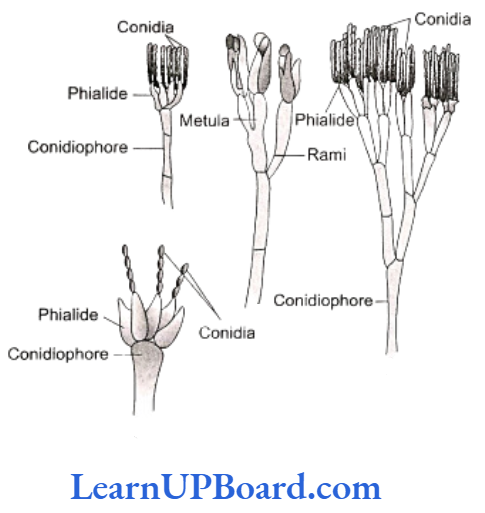
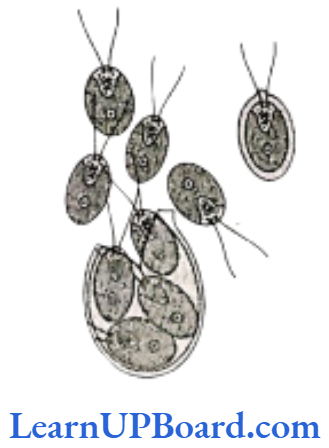
chapter 1 class 12 biology notes
In Chlamydomonas, under favorable condition, asexual re- production takes place by zoospores formation. The protoplast of cell divides to form 8-16 zoospores. They are pyramid shaped and anteriorly bifiagellate resembling the parent cell. The parent cell wall breaks and the zoospores are liberated in water. They enlarge and behave as an adult individual.
NEET Biology Notes For Reproduction In Organisms Sexual Reproduction
Sexual reproduction involves the formation and fusion of the male and female gametes, produced either by the same individual or by different individuals of opposite sex. The gametes fuse to form a zygote which develops to form a new organism. Sexual reproduction results in offsprings that are not identical to the parents or amongst themselves.
All organisms have to reach a certain stage of growth and maturity in their life, before they can reproduce sexually. This period of growth is called the juvenile phase. It is known as vegetative phase in plants.
The end of juvenile/vegetative phase, which marks the be- ginning of reproductive phase, can be seen easily in higher plants when they come to flowering.
Plants that are annual and biennial show clear-cut vegeta- tive, reproductive, and senescent phases, but in the perennial species, it is very difficult to clearly define these phases. Bam- boo species flower only once in their lifetime generally after 50-100 years. Strobilanthus kunthiana (neelakuranji) flowers once in 12 years.
Events in Sexual Reproduction
After the attainment of maturity, all sexually reproducing organisms exhibit events and processes that have remarkable fundamental similarity, even though the structures associated with sexual reproduction are indeed very different. These sequential events may be grouped into three distinct stages: (a) pre-fertilization, (b) fertilization, and (c) post-fertilization events.
- Pre-fertilization events: Two main pre-fertilization events are gametogenesis and gamete transfer.
- Gametogenesis: It refers to the process of formation of gametes-male and female. Gametes are haploid cells. In some algae, both gametes are structurally and functionally similar. It is not possible to categorize them into male and female gametes. They are, hence, called isogametes or homogametes. However, in a majority of sexually reproducing organisms, the gametes produced are of two morphologically distinct types (hetero- gametes). In such organisms, the male gamete is called the antherozoid or sperm and the female gamete is called the egg or ovum.
The male and female reproductive structures may be found in the same plant (bisexual) or in different plants (unisexual). In several fungi and some plants, terms such as homothallic and monoecious are used to denote bisexual condition while heterothellic and dioecious are used to describe unisexual condition.
In flowering plants, the unisexual male flower is called staminate (bearing stamens) while the female flower is called pistillate (bearing pistils). In some flowering plants, both male and female flowers may be present on the same individual (monoecious) or on separate individuals (dioe- cious). Some examples of monoecious plants are Acalypha, cucurbits, and coconuts and those of dioecious plants are mulberry, papaya, and date palm.
- Gametogenesis: It refers to the process of formation of gametes-male and female. Gametes are haploid cells. In some algae, both gametes are structurally and functionally similar. It is not possible to categorize them into male and female gametes. They are, hence, called isogametes or homogametes. However, in a majority of sexually reproducing organisms, the gametes produced are of two morphologically distinct types (hetero- gametes). In such organisms, the male gamete is called the antherozoid or sperm and the female gamete is called the egg or ovum.
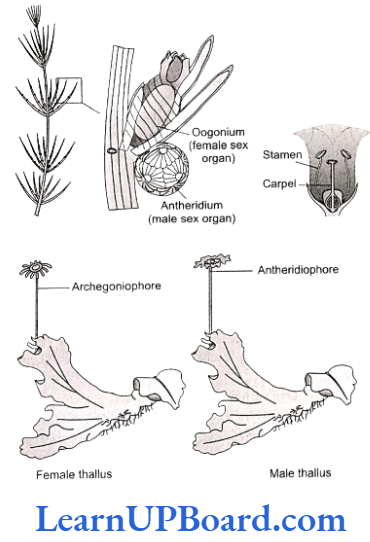
Several organisms belonging to monera, fungi, algae, and bryophytes have haploid plant body; but organisms belonging to pteridophytes, gymnosperms, and angiosperms, and most of the animals including human beings have diploid parental body. In diploid organisms, specialized cells called meiocytes (gamete mother cell) un- dergo meiosis. At the end of meiosis, only one set of chromosomes gets incorporated into each gamete.
Sexual reproduction in Chara and Marchantia: Chara is green algae. It is oogamous. The sex organs are highly specialized. While some workers preferred to call the male sex organ as antheridium and the female one as oogonium, others did not favor this terminology. They called the male sex organ as globule and the female one as nucule; this terminology is largely followed in Chara. The sex organs are borne on the adaxial face of the short lateral branch almost on each node.
ch 1 class 12 biology
The nucule occupies a higher position than the globule. While most of the species of Chara are monoecious, Catreus wallichii is dioecious. The globule matures prior to the nucule (protandrous). Each antheridium produces band-shaped, spirallycoiled biflagellate antherozoids. The oogonium contains a single egg. The egg is laiden with starch and oil globules.
In Marchantia, the archegonia are borne on spe- cial branches called archegoniophores or the female receptacles. The archegonia may be stalked or sessile. The archegoniophore, or carpocepha- lum, has rows of archegonia protected by invo- lucre or perichaetium. In some plants, a perianth also protects an archegonial group. The arche- gonia are flask-shaped structures distinguishable into a long neck and globular, swollen venter.
A multicelled stalk is also present in the archegonia of mosses, but in others, it is very short. The neck is one-cell thick. It is generally made up of six vertical rows of cells but in Jungermamnniales, it is composed of four or five vertical rows only. The neck is capped by four cover cells and contains varying number of neck canal cells inside.
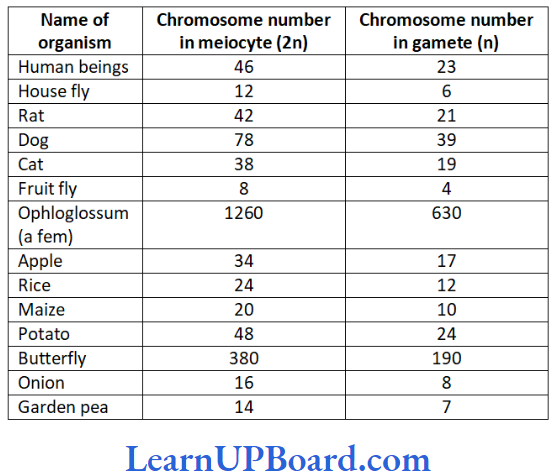
- Gamete transfer: After the formation of male and female gametes, they must be physically brought together to facilitate fusion (fertilization). Exceptions are a few fungi and algae in which both types of gametes are motile. There is a need of a medium through which the male gametes move. In several simple plants such as algae, bryophytes, and pteridophytes, water is the medium through which gamete transfer takes place a large number of male gametes, however, fail to reach the female gametes. To compensate this loss of male gametes, the number of male gametes produced is several thousand times the number of female gametes produced.
In seed plants, pollen grains are the carriers of male gametes and ovule bears the egg. Pollen grains are produced in anthers and, therefore, have to be transferred to the stigma before it can lead to fertilization.
- Gamete transfer: After the formation of male and female gametes, they must be physically brought together to facilitate fusion (fertilization). Exceptions are a few fungi and algae in which both types of gametes are motile. There is a need of a medium through which the male gametes move. In several simple plants such as algae, bryophytes, and pteridophytes, water is the medium through which gamete transfer takes place a large number of male gametes, however, fail to reach the female gametes. To compensate this loss of male gametes, the number of male gametes produced is several thousand times the number of female gametes produced.
class 12th biology reproduction in organisms
- Fertilization events: The most important event of sexual reproduction is the fusion of gametes. This process is called syngamy. It results in the formation of a diploid zygote.
In most aquatic organisms, such as in majority of algae and fishes as well as amphibians, syngamy occurs in the external medium (water). This type of gametic fusion is called external fertilization. In a majority of plants, such as bryophytes, pteridophytes, gymnosperms, and angiosperms, syngamy occurs inside the body of the organism. Hence, this process is called in- ternal fertilization. - Post-fertilization events: In sexual reproduction, the events that take place after the formation of zygote are called post-fertilization events.
The process of development of embryo from the zygote is called embryogenesis. In animals, the zygote starts developing soon after its formation. In flowering plants, after fertilization, ovary develops into fruit and ovules mature into seeds. Inside the mature seed is the progenitor of the next generation-the embryo.
